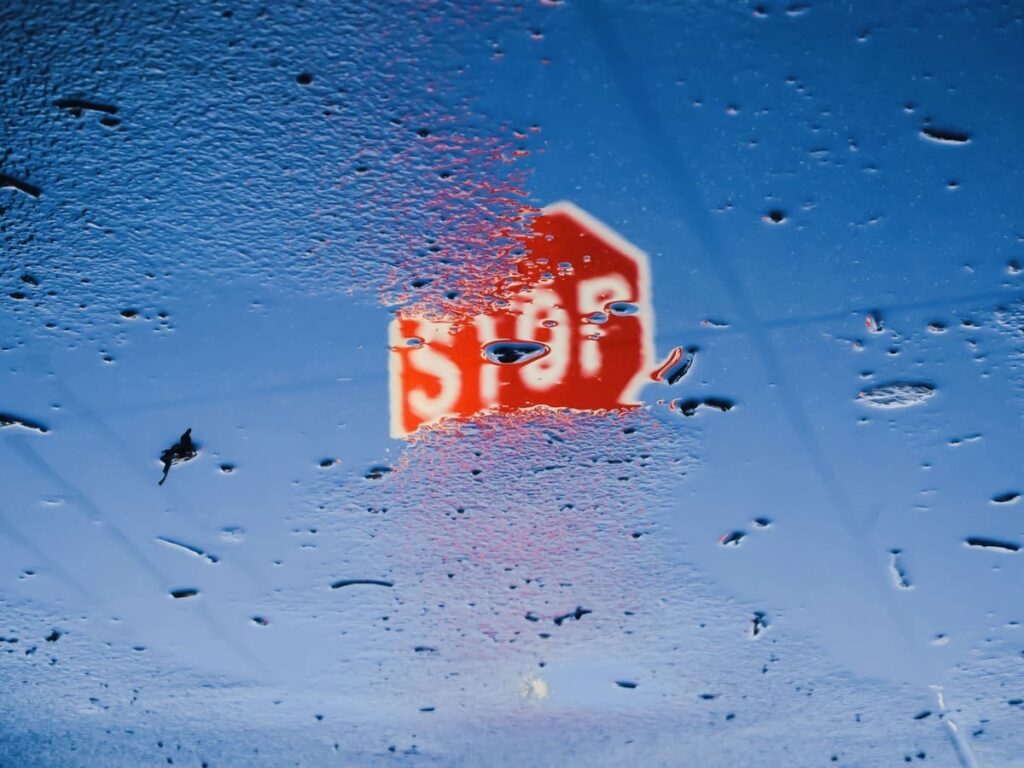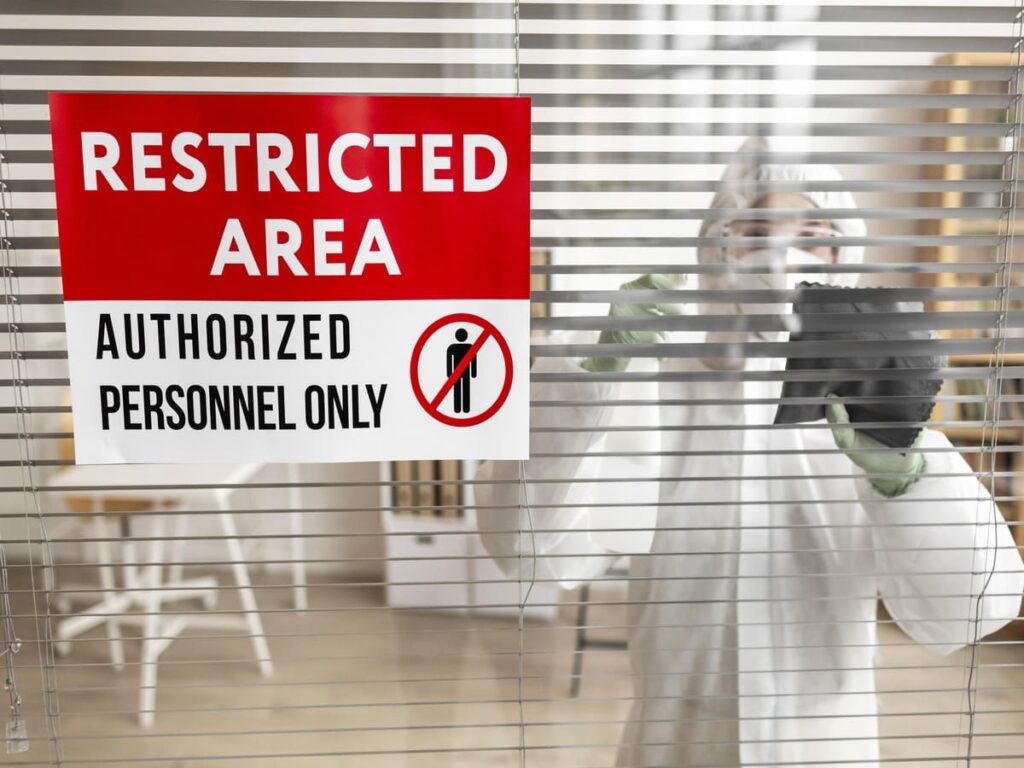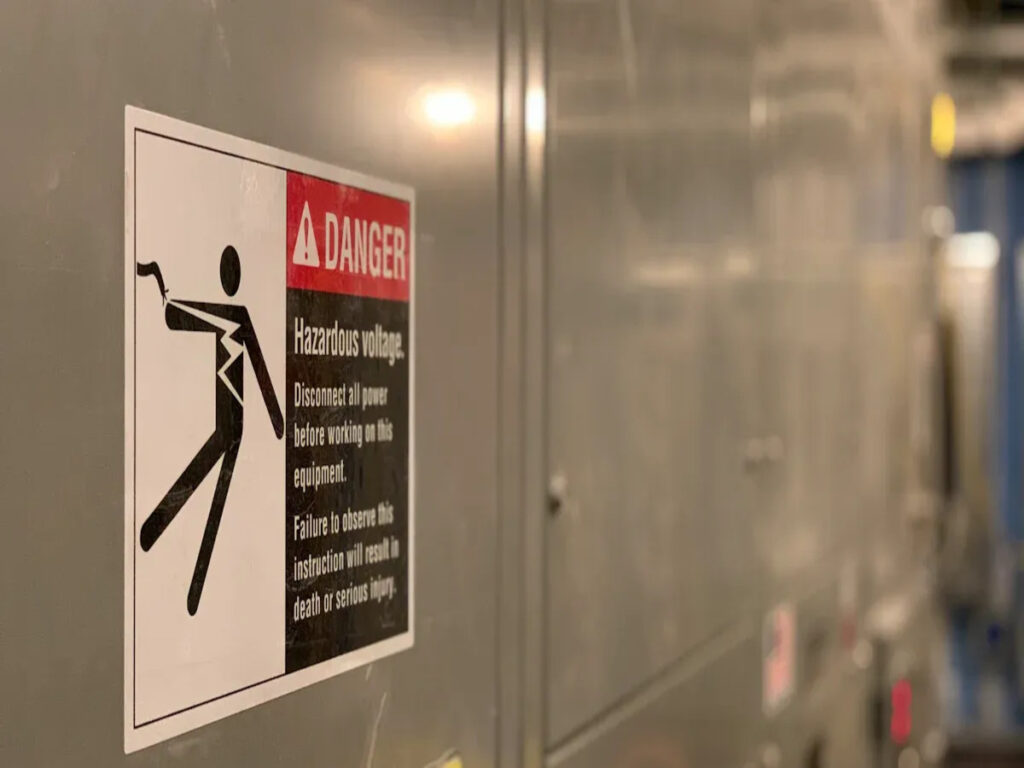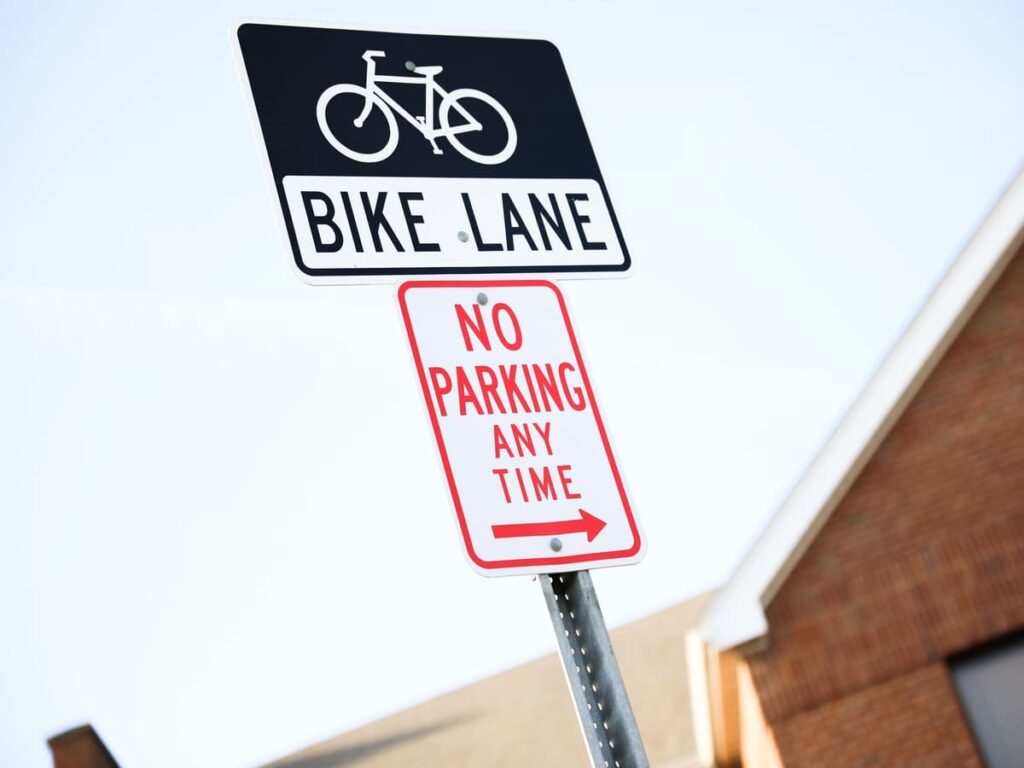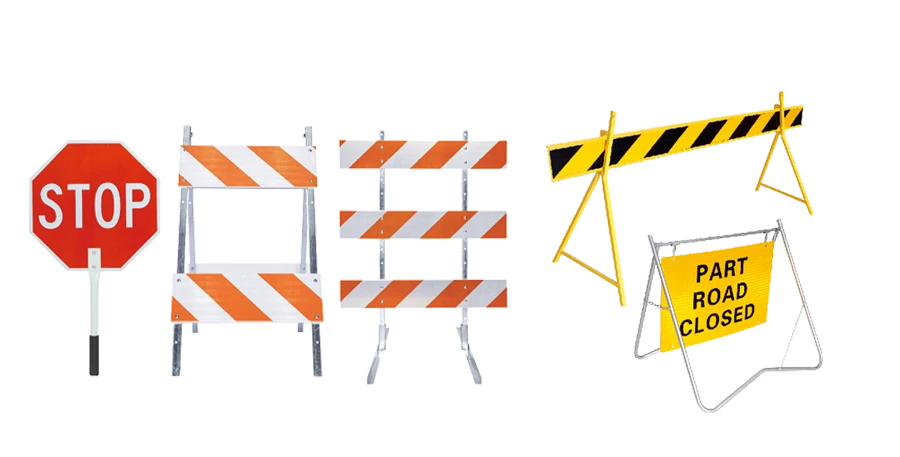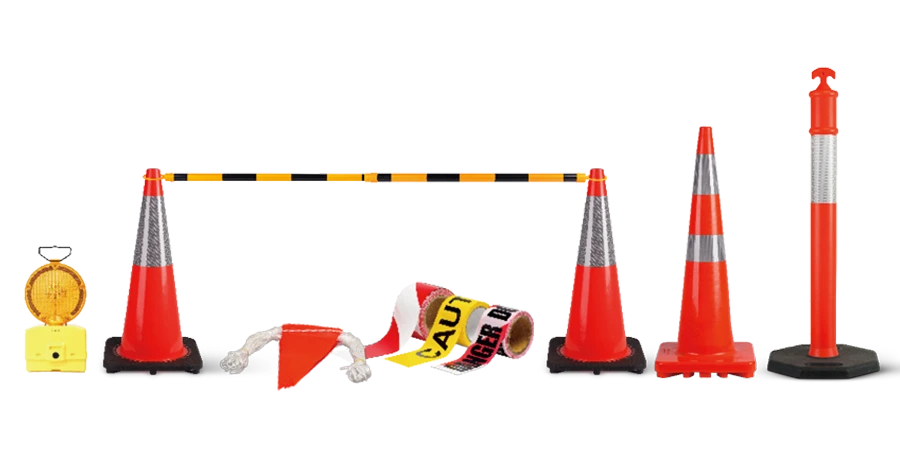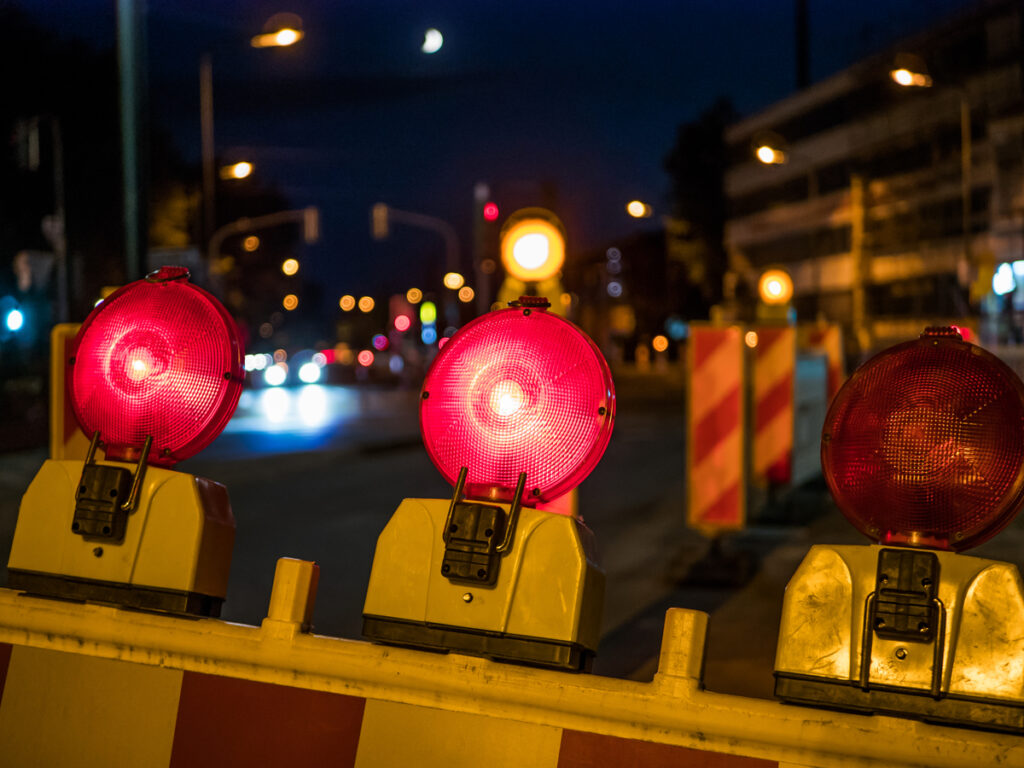
Luci di avvertimento a LED di solito sono migliori per la sicurezza stradale. Ogni anno, Gli infortuni sul traffico stradale uccidono oltre un milione di persone. Fino a 50 milioni di persone si fanno male negli incidenti ogni anno. La possibilità di crash di notte aumenta quando le luci sono cattive. Gli studi mostrano una buona illuminazione stradale può ridurre i tassi di arresto fino a 30%.
Più persone ora usano le luci di avvertimento a LED. In 2023, Sopra 67% di unità vendute in tutto il mondo sono state guidate. Sono molto luminosi, Usa poca energia, e durano a lungo. Questo li rende una buona scelta per il traffico e la sicurezza pubblica.
A Optraffic, Offriamo di alta qualità Luci di avvertimento a LED progettato per migliorare la sicurezza stradale e migliorare la visibilità. I nostri prodotti sono costruiti per soddisfare i più alti standard di sicurezza, Garantire che conducenti e pedoni siano al sicuro. Esplora la nostra gamma oggi e dai un'occhiata al nostro blog, Luci di avvertimento a LED per la sicurezza stradale: Cosa sapere prima di acquistare, Per ulteriori approfondimenti.
Vantaggi per la sicurezza
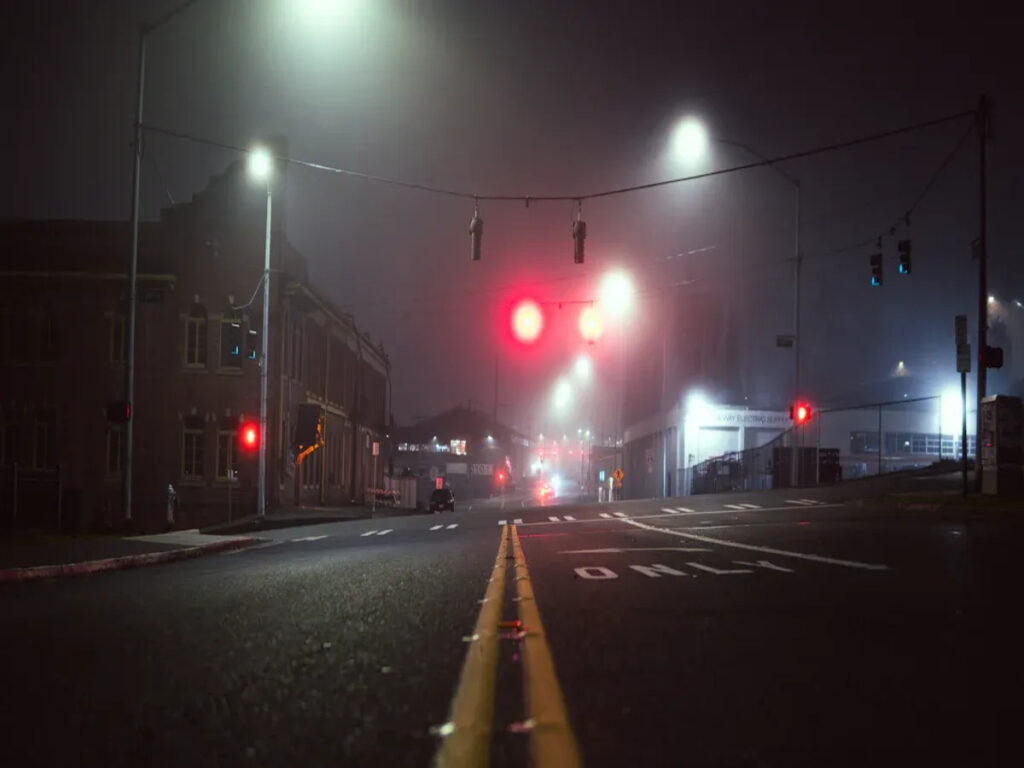
Visibilità e risposta
Le luci di avvertimento a LED brillano molto più luminose delle vecchie luci a incandescenza. Questo aiuta i conducenti a vedere pericoli e segnali stradali più chiaramente. È molto utile di notte o quando il tempo è male. Gli esperti dicono che i LED consumano fino a 80% meno energia. Aiutano anche i conducenti a vedere meglio nella nebbia o nella pioggia. Le travi focalizzate dai LED riducono il bagliore. Questo rende più facile individuare le cose vicino al suolo. Questo è importante per le luci della nebbia e i veicoli di emergenza.
Le luci di avvertimento a LED si accendono subito. Ciò consente ad altri conducenti di reagire rapidamente alle luci lampeggianti sulle auto della polizia, ambulanze, o veicoli da strada. I LED rimangono freschi e durano più a lungo. Funzionano bene sotto la pioggia, nevicare, e nebbia. Gli studi dimostrano che le vecchie luci a incandescenza con toni gialli a volte possono funzionare meglio nella nebbia. Ma i LED sono di solito più luminosi e risparmiano più energia. La temperatura del colore dei LED può cambiare quanto funzionano bene nella nebbia. La maggior parte delle nuove luci di avvertimento a LED sono fatte per aiutare le persone a vedere meglio e stare al sicuro.
Riduzione degli incidenti
Molte città ora usano le luci di avvertimento a LED per rendere le strade più sicure. Ma la ricerca di Birmingham, Regno Unito, Ho trovato qualcosa di sorprendente. Dopo aver inserito luci a LED luminose, Il numero di incidenti stradali è salito invece di giù. La tabella seguente mostra cosa è cambiato:
| Metrica | Modifica osservata dopo l'installazione di LED | Intervallo di confidenza (95%) |
|---|---|---|
| 24-Collisione del traffico stradale dell'ora (RTC) Valutare | +11% | 2% A 20% |
| Tasso RTC solo oscurità | +16% | 2% A 32% |
| Oscurità RTC Tasso regolato per luce diurna RTC | +4% (non statisticamente significativo) | -12% A +23% |
Questo studio non ha trovato meno incidenti dopo il passaggio alle luci a LED. Invece, Ci sono stati più incidenti, soprattutto di notte. I risultati mostrano che i LED aiutano le persone a vedere meglio. Ma altre cose, Come il modo in cui i conducenti agiscono e il traffico, Importa anche per i tassi di incidenti.
Miglioramenti nella sicurezza generale su strada
Le luci di avvertimento a LED hanno reso le strade più sicure, Soprattutto nei secche pedonali e nei luoghi senza semafori. Gli studi mostrano che i conducenti si fermano per le persone che attraversano più spesso quando vengono utilizzate le luci di avvertimento a LED. Ecco alcuni punti chiave:
- Altri conducenti si fermarono ai camicie di notte quando venivano usate le luci di avvertimento a LED.
- Con normali luci stradali, soltanto 19% di conducenti si fermarono.
- Speciali luci a LED fatte 38% dei conducenti si fermano.
- Usando i fari lampeggianti e le strisce LED insieme fatte 63% dei conducenti si fermano.
- Le strisce a LED nel marciapiede e i fari lampeggianti hanno aiutato i conducenti a vedere le persone attraversare e prestare maggiore attenzione.
- Questo sistema ha funzionato meglio di notte e quando è stato difficile da vedere, che è importante per la sicurezza.
- Altri sistemi a LED, come motivi lampeggianti sui segni, ha anche fatto fermare più conducenti.
- Rispetto ad altri modi, Le luci di avvertimento a LED hanno aiutato i conducenti a fermare di più e hanno reso gli incroci più sicuri.
Le luci di avvertimento a LED aiutano a mantenere i conducenti e le persone che camminano al sicuro. Altri sistemi di traffico ora li usano. Aiutano le persone a vedere meglio e reagiscono più velocemente. Questi cambiamenti aiutano a ridurre gli incidenti e rendono le strade più sicure per tutti.
Confronto dei costi
Investimento iniziale
Le luci di avvertimento a LED costano di più da acquistare rispetto alle tradizionali luci a incandescenza. Una luce di strada a LED di solito costa tra $200 E $500. Un tradizionale sodio ad alta pressione (HPS) leggero solo costi $50 A $150. La tabella seguente mostra la differenza di prezzo:
| Tipo di luce | Intervallo di costi di acquisto iniziale | Costo relativo rispetto agli HP |
|---|---|---|
| Luci HPS tradizionali | $50 – $150 | Basale |
| Lampioni a LED | $200 – $500 | Circa 4 volte più alto |
I LED necessitano di infissi speciali e talvolta nuovi cablaggi o poli. L'installazione di sistemi a LED può costare $5,000 A $20,000 o più. Il prezzo dipende da quanto sia grande e complesso il progetto. Le luci a incandescenza tradizionali sono inizialmente più economiche da installare.
Manutenzione e durata della vita
Le luci di avvertimento a LED durano molto più a lungo delle luci a incandescenza tradizionali. La maggior parte dei LED funziona per 50,000 A 100,000 ore. Le luci a incandescenza tradizionali durano solo 10,000 A 25,000 ore. Ciò significa che i LED non devono essere sostituiti così spesso. La tabella seguente confronta la durata e quanta cura di cui hanno bisogno:
| Caratteristica | Luci di avvertimento a LED | Illuminazione tradizionale (HPS/Halide metal) |
|---|---|---|
| Durata media | 50,000 A 100,000 ore | 10,000 A 25,000 ore |
| Manutenzione | Sostituzioni meno frequenti | Sostituzioni più frequenti |
| Dissipazione del calore | Efficiente, riduce l'usura | Meno efficiente, usura più veloce |
I LED necessitano anche di meno pulizie e meno riparazioni. Questo aiuta a risparmiare denaro per la manutenzione nel tempo. Sono ancora necessari controlli e pulizie annuali. Ma perché i LED durano più a lungo, Vi è meno interruzione e minori i costi del lavoro.
Costo totale nel tempo
All'inizio le luci di avvertimento a LED costano di più ma risparmiano più tardi. Sopra 10 anni, I sistemi a LED di solito costano 15-25% Meno delle tradizionali luci a incandescenza. Questo perché usano meno energia, Hai bisogno di meno sostituti, e hanno costi di manutenzione inferiori. Molte città del Regno Unito hanno risparmiato un sacco di soldi passando ai LED. Sheffield usato fino a 65% meno energia e pagato meno per la manutenzione. Edimburgo prevede di risparmiare £ 54 milioni in 20 anni utilizzando i lampioni a LED.
Il grafico seguente mostra il costo totale per le luci di avvertimento a LED di alta qualità e più economiche 10 anni:
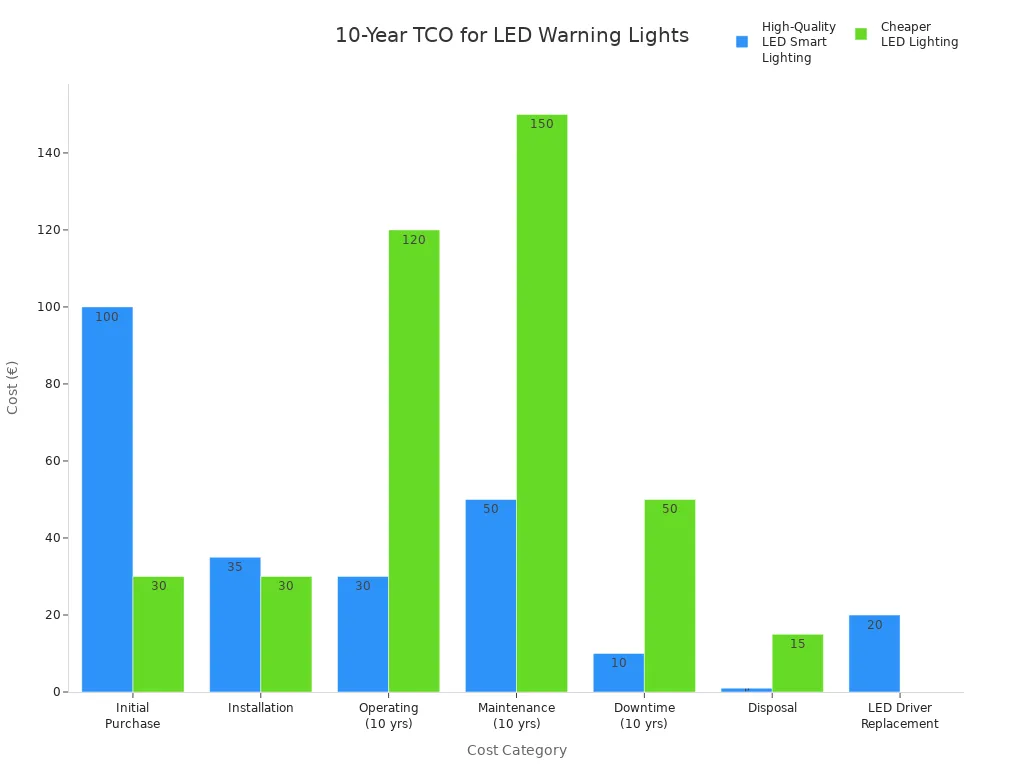
Col tempo, Il risparmio sulle bollette energetiche e sulla manutenzione rende i LED una scelta intelligente per la sicurezza stradale.
Efficienza energetica
Consumo energetico
Le luci di avvertimento a LED usano molta meno energia rispetto alle luci più vecchie. La maggior parte delle lampadine a LED ha bisogno solo di un po 'di potenza per brillare come le lampadine a incandescenza o alogena. Per esempio, an LED warning light that gives 400–500 lumens uses about 6–7 watts. An incandescent bulb with the same brightness uses around 40 watts. This means LED warning lights use about 90% meno energia. Halogen bulbs use less power than incandescent, but they still use more than LEDs.
| Luminosità (Lumens) | Incandescent Power (Watts) | LED Power (Watts) |
|---|---|---|
| 400 - 500 | ~40W | 6 – 7W |
| 650 - 850 | ~60W | 7 – 10W |
| 1000 - 1400 | ~75W | 12 – 13W |
| 1450 - 1700+ | ~100W | 14 – 20W |
| 2700+ | ~150W | 25 – 28W |
Cities that use LED warning lights save lots of energy. Chicago saves about 181.7 million kilowatt-hours every year after switching to LED street lights. This cuts energy bills by more than half. Some cities in Europe have saved up to 80% on energy costs after changing to LEDs. These results show how much better LED technology is for saving energy.
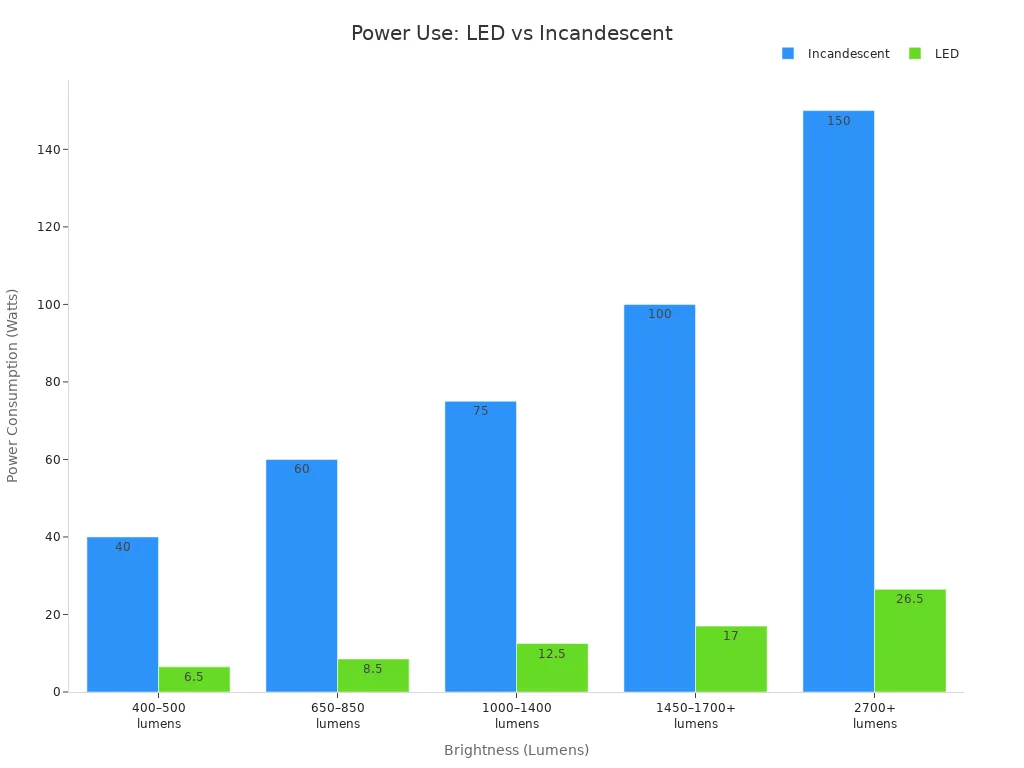
Impatto ambientale
LED warning lights are good for the environment. Usano meno energia, Quindi le centrali elettriche fanno meno emissioni di carbonio. Una lampadina a LED può risparmiare 400 chili di anidride carbonica nel corso della sua vita rispetto a un bulbo a incandescenza. I LED durano molto più a lungo, spesso fino a 100,000 ore. Ciò significa meno rifiuti e meno nuovi lampadine necessari.
Le luci di avvertimento a LED non hanno materiali pericolosi come il mercurio, che hanno alcuni vecchi lampadine. Questo li rende più sicuri per l'ambiente e più facili da buttare via.
Altre cose buone includono meno calore e un migliore controllo di dove va la luce. I LED aiutano a fermare l'inquinamento dalla luce, che protegge gli animali e mantiene il cielo notturno più chiaro. Le nuove regole ora preferiscono i LED perché funzionano bene e sono migliori per il pianeta. Le città che usano le luci di avvertimento a LED aiutano a rendere il futuro più pulito e più verde.
Durata e affidabilità
Resistenza alle intemperie
Le luci di avvertimento a LED funzionano bene con il tempo difficile. Continuano a brillare in luoghi molto freddi, Anche sotto -25 ° F.. Le lampadine tradizionali possono sfarfallare o diventare fiocne quando si blocca. I LED non lo fanno. Il loro design solido significa neve, ghiaccio, E il vento non li spezza facilmente. Le vecchie luci possono diventare troppo calde o crack se il tempo cambia velocemente. I LED emettono meno calore, Quindi il ghiaccio non si accumula sul loro obiettivo. Buoni infissi a LED hanno alti Valutazioni IP come IP65 o IP67. Queste valutazioni li proteggono dall'acqua e dalla polvere. Questo mantiene le luci funzionanti con forti piogge o tempeste di polvere.
Le luci di avvertimento a LED ben fatte rimangono luminose e risparmiano energia in qualsiasi tempo. Questo è molto importante per la sicurezza stradale, Soprattutto in inverno o tempeste.
Shock e vibrazione
Le luci di avvertimento a LED sono forti contro i dossi e le scuotere. La loro costruzione solida significa che non ci sono fili sottili da scattare. Gli attrezzi di sicurezza stradale vengono colpiti e scossi molto. I LED continuano a lavorare quando i vecchi bulbi potrebbero smettere. Per esempio, Le barre luminose a LED su auto di emergenza o macchine da costruzione non si rompono facilmente. Inoltre non fanno troppo caldo. Ciò significa che falliscono meno e necessitano di meno fissaggio.
- I LED funzionano bene su strade accidentate, siti di costruzione, e auto di emergenza.
- I vecchi bulbi spesso si rompono perché i loro fili si scattino o le connessioni si allentano.
Prestazioni coerenti
Le luci di avvertimento a LED funzionano sempre bene in momenti importanti. Si accendono subito, Anche quando fa freddo. Non hanno bisogno di tempo per riscaldarsi. Questa luce rapida è la chiave per le auto di emergenza e le zone di costruzione. Ogni secondo conta lì. I LED durano molto più a lungo, Spesso 50,000 A 100,000 ore. Ciò significa che non smettono di funzionare improvvisamente e aiutano a mantenere le strade al sicuro.
| Aspetto | Luci di avvertimento a LED | Illuminazione tradizionale |
|---|---|---|
| Resistenza alle intemperie | Alto (IP65 - IP68, funziona in estremo freddo/calore) | Inferiore, incline al fallimento |
| Shock & Vibrazione | Eccellente (stato solido, Nessun filamento) | Povero, I filamenti si rompono facilmente |
| Durata | 50,000–100.000 ore | 1,000–2.500 ore |
| Affidabilità nelle emergenze | Molto alto, Inizio istantaneo, output costante | Inferiore, Rischio di improvviso fallimento |
Le luci di avvertimento a LED sono affidabili per i lavori di sicurezza stradale. La loro costruzione dura e il lavoro costante aiutano a mantenere i conducenti, lavoratori, e le persone che camminano al sicuro con tutti i tipi di tempo.
Segnali stradali e luci a LED
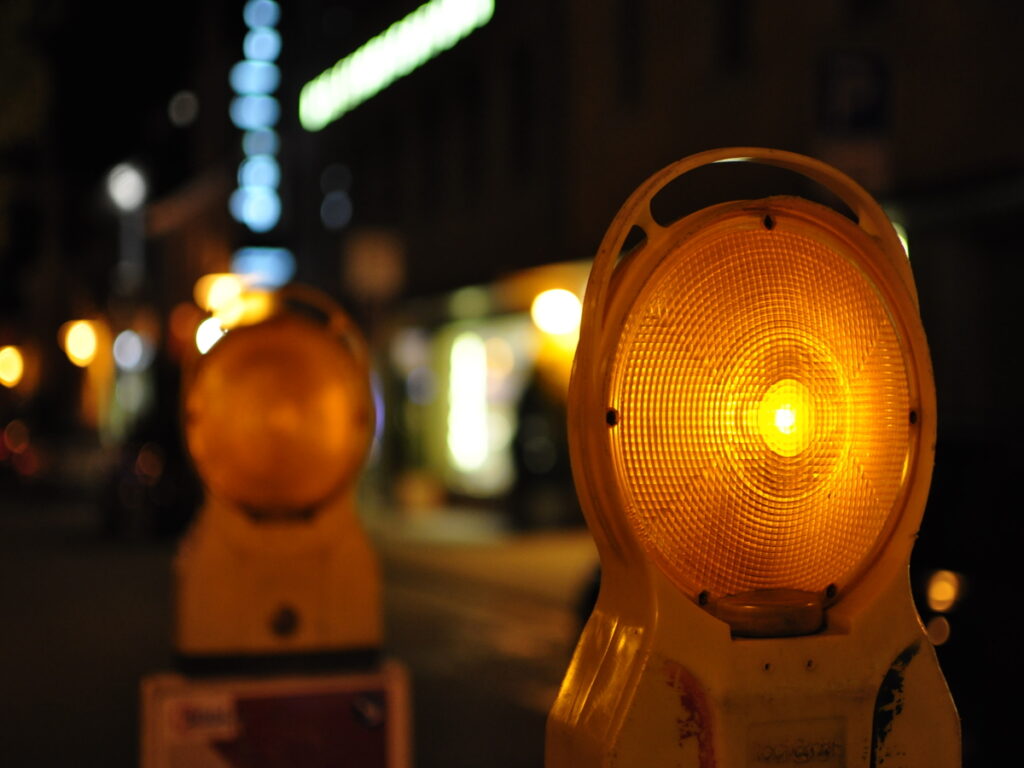
Applicazioni del mondo reale
Molte città ora usano segnali stradali a LED per rendere le strade più sicure. Questi segnali si trovano a travolgenti incrocio, attraversamenti per le persone, e rotonde. Consigli a Londra, Manchester, E Birmingham ha cambiato vecchi bulbi in nuovi semafori a LED. I veicoli di emergenza come le ambulanze e le auto della polizia usano il semaforo a LED per segnali rapidi e chiari. I siti di costruzione utilizzano spesso segnali stradali a LED portatili per controllare le modifiche alla strada.
I segnali stradali LED aiutano a fermare la confusione e l'attesa. Le loro luci brillanti possono essere viste alla luce del sole e alla forte pioggia. Questo li fa funzionare bene con qualsiasi tempo.
Alcuni aeroporti e attraversamenti ferroviari utilizzano il semaforo a LED per guidare le auto e le persone in sicurezza. Questi segnali usano meno energia e necessitano di meno fissaggio, che consente di risparmiare denaro per i consigli.
Colore e qualità della luce
I segnali stradali a LED mostrano colori luminosi e chiari. A differenza delle vecchie lampadine, Il semaforo a LED emana il rosso puro, giallo, e colori verdi senza usare i filtri. Questo rende le luci luminose e facili da vedere. I conducenti possono individuare questi colori da lontano o alla forte luce del giorno.
- I moduli a LED dei migliori produttori brillano più luminosi dei vecchi segnali.
- Alcuni segnali a LED possono sembrare un po 'dotty, Ma un buon design li rende lisci.
- La parte illuminata di ciascun segnale cambia come i conducenti vedono il colore e la luminosità.
Una tabella seguente mostra i modi principali per i semafori a LED e i vecchi segnali sono diversi:
| Caratteristica | Semaforo a LED | Segnali tradizionali |
|---|---|---|
| Precisione del colore | Alto | Moderare |
| Luminosità | Superiore | Inferiore |
| Uso di energia | Basso | Alto |
| Manutenzione | Minimo | Frequente |
Regole di traffico, come quelli del Institute of Transportation Engineers (Ite), dire che i segnali stradali a LED devono seguire le regole rigorose per il colore, luminosità, e dove sono messi. Queste regole aiutano a mantenere i segnali sicuri e utili per tutti in viaggio.
Gestione del traffico e tendenze future
Sistemi intelligenti
Le città di tutto il mondo ora utilizzano sistemi intelligenti per aiutare a controllare il traffico. Questi sistemi includono luci di avvertimento a LED in reti intelligenti di semafori. Sensori e telecamere raccolgono dati sul traffico in tempo reale. L'intelligenza artificiale aiuta a capire queste informazioni. Il sistema può quindi cambiare i tempi del segnale e gestire come si muovono le auto. In posti come New York e Singapore, I sistemi intelligenti utilizzano segnali stradali a LED. Questo aiuta a fermare gli ingorghi e consente ai veicoli di emergenza di superare più velocemente.
Il semaforo a LED si accende rapidamente e sono facili da vedere. Risparmono energia e durano a lungo. Questo li rende fantastici per il controllo del traffico intelligente. Molti sistemi intelligenti possono essere controllati da lontano. I gestori del traffico possono cambiare segnali o le luci di avvertimento da un posto principale. Alcune luci di avvertimento a LED usano energia solare. Funzionano ancora se il potere principale si spegne. Tutte queste cose aiutano a rendere le strade più sicure e trafficate più facili da gestire.
L'uso delle luci di avvertimento a LED in modi intelligenti indica un minor numero di arresti anomali, Meno inquinamento, e viaggi più fluidi per tutti.
Adozione più ampia
Più città e città scelgono la tecnologia LED per il controllo del traffico. Ai governi e ai pianificatori come segnali stradali guidati perché risparmiano e funzionano bene. Quando i segnali stradali vengono aggiornati, vengono spesso aggiunti nuovi moduli a LED. Questi possono durare fino a dieci anni. Ciò significa meno fissaggio e strade più sicure.
Alcuni motivi per cui più luoghi usano i LED sono:
- Le città hanno più auto e hanno bisogno di modi migliori per controllare il traffico.
- Le nuove regole dicono che la costruzione e le zone scolastiche devono avere luci di avvertimento brillanti.
- I sistemi a LED solari e wireless sono buoni dove la potenza non è stabile.
- Speciali luci di avvertimento a LED sono realizzate per veicoli di emergenza e strade trafficate.
In futuro, i sistemi diventeranno ancora più intelligenti. Nuovi chip a LED brilleranno più luminosi e mostreranno colori migliori. I microprocessori aiuteranno a mirare la luce esattamente dove è necessaria. IoT consentirà ai gestori del traffico di guardare e controllare i sistemi da qualsiasi luogo. Queste modifiche renderanno meglio il controllo del traffico e manterranno tutti più sicuri.
| Tendenza | Vantaggio per la gestione del traffico |
|---|---|
| Integrazione del sistema intelligente | Risposta e controllo in tempo reale |
| Durata più lunga a LED | Meno sostituzioni, Costi inferiori |
| Caratteristiche wireless e solari | Operazione affidabile in tutte le condizioni |
| Personalizzazione e aggiornamenti | Soluzioni flessibili per ogni strada |
Le luci di avvertimento a LED sono migliori dell'illuminazione tradizionale. Usano meno energia e durano molto più a lungo. Funzionano bene in tutti i tipi di tempo. La tabella seguente mostra le differenze principali:
| Aspetto | Luci di avvertimento a LED | Luci a incandescenza tradizionali |
|---|---|---|
| Efficienza energetica | Converte fino a 80% di energia elettrica alla luce | Converte 10% di energia elettrica alla luce (90% sprecato come calore) |
| Durata | Fino a 50,000 ore (Di 50 volte più a lungo) | In giro 1,000 ore |
| Durabilità & Resistenza alle intemperie | Alta durata; affidabile nel freddo | Meno resistente; incline al fallimento nel freddo |
| Manutenzione & Costi operativi | Significativamente ridotto a causa della lunga durata e della durata | Più alto a causa di frequenti sostituti e guasti |
Molte città ora scelgono sistemi a LED per rendere le strade più sicure. Aiutano anche a risparmiare denaro nel tempo. I gruppi di sicurezza stradale affermano che le luci di avvertimento a LED sono le migliori per strade e incroci trafficati. Man mano che la tecnologia migliora, L'illuminazione a LED contribuirà a rendere le strade più sicure e più intelligenti.
Domande frequenti
Perché le luci di avvertimento a LED usano meno energia dell'illuminazione tradizionale?
Luci di avvertimento a LED trasformare la maggior parte dell'elettricità in luce. I lampadine tradizionali sprecano molta energia come calore. Ciò significa che le città spendono meno soldi e fanno meno inquinamento.
Quanti soldi può risparmiare qualcuno passando alle luci di avvertimento a LED?
Molte città risparmiano 65% sulle loro bollette energetiche. Le luci a LED durano più a lungo e non hanno bisogno di fissarsi così spesso. Oltre dieci anni, Le persone spendono meno soldi che con le vecchie luci.
Sono luci di avvertimento a LED abbastanza luminose nella nebbia o nella pioggia?
Le luci di avvertimento a LED sono molto luminose. I loro raggi focalizzati aiutano i conducenti a vedere pericoli in caso di maltempo. La maggior parte dei nuovi LED funziona bene nella nebbia, piovere, e neve.
Mancia: Scegli Luci di avvertimento a LED con temperatura di colore regolabile per una migliore visione nella nebbia.
Qual è la durata della vita di una luce di avvertimento a LED rispetto a una lampadina a incandescenza?
| Tipo di luce | Durata media |
|---|---|
| Luce di avvertimento a LED | 50,000–100.000 ore |
| Bulbo incandescente | 1,000–2.500 ore |
Le luci di avvertimento a LED durano molto più a lungo. Hanno bisogno di cambiare meno spesso e lavorare bene per la sicurezza stradale.


